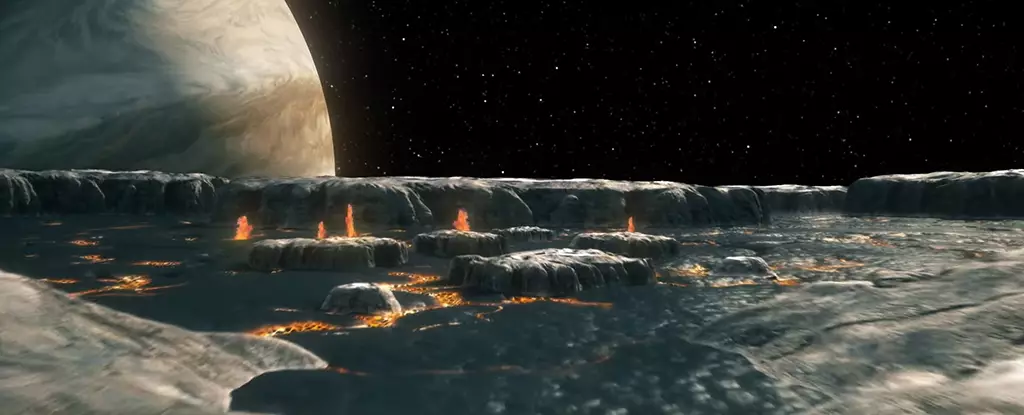Jupiter’s moon Io has long intrigued scientists with its dramatic and tumultuous landscape, characterized by over 400 active volcanoes—more than any other celestial body in the Solar System. Previously, researchers operated under the assumption that these volcanic phenomena were driven by a vast ocean of molten rock beneath Io’s surface. However, recent findings challenge this long-held belief, suggesting a far more complex internal structure that may fundamentally alter our views on volcanic processes not only on Io but across the cosmos.
The breakthrough study, leveraging data from NASA’s Juno spacecraft coupled with gravitational insights and tidal deformation measurements, reveals that Io’s volcanic activity stems from localized magma chambers embedded within a largely solid mantle. This redefinition of Io’s internal configuration upends previous models suggesting a substantial magma ocean influencing volcanic eruptions. It highlights that our comprehension of celestial geology requires reexamining how solid and molten materials interact in such extreme conditions.
Historically, Io was first observed by Galileo in 1610, but it wasn’t until 1979, with the Voyager 1 mission, that scientists discovered its volcanism. Linda Morabito, an imaging scientist at NASA’s Jet Propulsion Laboratory, unveiled the first image capturing a volcanic plume. This pivotal moment sparked a wealth of inquiry into the mechanisms behind Io’s geological volatility. Scott Bolton, a space physicist involved in the recent research, emphasized the mystery surrounding the sources of Io’s volcanic energy, questioning whether it was a concentrated event or part of a larger system.
Io’s orbit around Jupiter is not a straightforward journey; its elliptical path exposes it to intense gravitational forces from the massive planet. This phenomenon, termed tidal flexing, generates substantial internal heat as the moon’s shape is reshaped under Jupiter’s immense gravitational influence. The energy released through tidal flexing is profound, leading to significant melting of Io’s interior. However, the study underscores that the extent of this flexing does not support the existence of a global lava ocean, complicating previous models that might have oversimplified the moon’s geological processes.
Bolton’s research illustrates that while Io certainly experiences extreme heat from tidal forces, the geological outcomes and lava flow patterns are consistent with a predominantly solid interior. The volcanism is therefore not a continuous eruption from a global magma reservoir but a series of localized events, each with its own unique magma supply. This nuanced understanding reveals that volcanic activity is shaped more by isolated magma pockets than a singular ocean of molten material.
These findings have broader implications beyond Io, influencing our understanding of other celestial bodies. The insights gained can inform future explorations of myriad moons, like Europa and Enceladus, which also showcase signs of geological activity. The principles observed in tidal flexing and localized heating could enhance our understanding of exoplanets and potentially habitable super-Earths.
By adapting our models of how tectonic processes function on different celestial bodies, scientists can gain richer perspectives on planetary formation, evolution, and even the potential for life elsewhere. Ryan Park, another researcher involved in the study, remarked on the ripple effects of this research, encouraging continued exploration into the geological complexity of both moons in our Solar System and beyond.
The shifting paradigm of Io’s volcanic activity signifies a pivotal leap in our comprehension of planetary geology. The analysis prompted by Juno’s high-resolution data reshapes our perspective on the interplay between solid and molten materials within celestial bodies. As scientists continue to probe the mysteries of Io and similar worlds, we gain profound insights into the dynamic processes that govern not only volcanic activity but also the broader narrative of our Solar System’s evolution. The ongoing exploration promises to unveil further complexities of planetary systems and may one day lead to the discovery of new Earth-like worlds beyond our own.


Leave a Reply